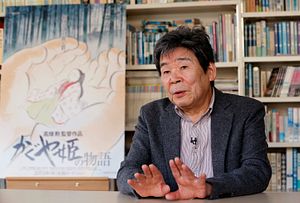The role of Isao Takahata in transforming the cinematic art form of animation, especially through the nuanced treatment by his films of complex issues like war, environmental destruction, and personal and national identities, cannot be understated. Takahata, co-founder of the iconic Studio Ghibli, passed away April 5, 2018.
Grave of the Fireflies, his 1988 classic about a little boy and his younger sister’s fight for survival in the aftermath of the Japanese surrender in World War II and the American firebombing of Tokyo, changed mainstream perceptions of the nature and possibilities of the genre.
While the poignant symbolism evoked the wonder and childhood that were being stolen from these innocent children, the stylized and extraordinarily accurate depictions of the landscape captured the ubiquity of the harrowing details of the destruction surrounding them.
It was this ability to realistically capture the nuances of everyday lives and emotions that was particularly pioneering about Takahata and his movies.
This ability was showcased further in the acclaimed Only Yesterday (1991), a film that dealt with the story of a 27-year-old Tokyo woman named Taeko. As she takes a holiday working in an exquisitely animated safflower farm with relatives, Takahata interweaves her memories of childhood poignantly capturing the young girl’s childhood dreams and the tribulations of adolescence, especially growing up with a strict father and consequential social constructs.
The depth and detail afforded to the little girl’s emotions and experience, which in turn continued to influence the yearnings and decisions of the young woman she grew up to be, made the film immensely identifiable and moving. The movie is also remembered for its beautifully-crafted final scene, which provides a sense of closure to the story.
Despite its slow and reflective pace, Only Yesterday surprisingly became the highest grossing domestic film of the year in Japan.
The movie also explores an environmental theme ever-present in Takahata’s movies in the form of Toshio, a young man with whom Taeko initially strikes up a friendship. Toshio, having been disillusioned with the impersonal nature of many aspects of city life, left his job in the city to start an organic farming business.
The lucid recreation and celebration of natural landscapes and forests in the movie would become a common theme in Takahata’s art.
The importance of these themes to the director would be also later seen in Pom Poko (1994), which dealt with transforming Japanese raccoon dogs inspired by traditional folklore and possessing a highly mischievous and charming character and their fight against an expanding urban housing development which threatens their land and food resources,
His last film was the Academy Award-nominated Princess of Kaguya (2013). Inspired by a Japanese folktale, the film tells the introspective coming of age story of a tiny girl discovered by a bamboo cutter inside a shining stock of bamboo.
The impressionistic and sophisticated hand-drawn animation won high acclaim and reaffirmed Takahata’s ability to reinvent his style as required by his stories, further highlighting the pioneering nature of his work.
Takahata also served as the artistic producer for The Red Turtle (2016), produced by Ghibli and directed by Dutchman Michael Dudok de Wit.
A minimalistic and wordless film based on the life of a man deserted in an island and his experiences with a mysterious giant red turtle, the film is characteristically multi-layered and metaphoric, and it was praised for the use of color and light in the animation.
Isao Takahata’s films complemented the work of his legendary Studio Ghibli partner Hayao Miyazaki, as the studio redefined the very nature of animation at its peak and has now left a stunning cinematic legacy in the wake of his passing.
Kiran Mohandas Menon is a lawyer currently based in Nuremberg, Germany. His writing has been featured in various international publications.

































